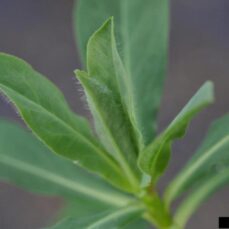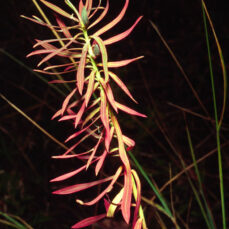Leafy Spurge (Euphorbia esula)

Photo by Chris Evans, University of Illinois, via Bugwood.org
Management Strategy
Squamish
Whistler
Pemberton
Vectors of Spread
Synonyms
Also known as “Wolf’s Milk”
ID Characteristics
General: Leafy spurge is a perennial plant in the Euphorbiaceae (spurge) family.
Flowers: The small umbrella-shaped flowers are yellowish-green and lack petals and sepals. The flowers are supported by two heart-shaped, green, leaf-like bracts.
Stems: The stems are smooth, hairless and grow in clumps. Stems contain a milky, white sap. Leafy spurge is 0.2 to 1 m tall.
Leaves: The narrow, waxy leaves are attached directly to the stem and are up to 7 cm long. The leaves are blue-green in the spring/early summer and turn reddish-orange in late summer.
Seeds: The light grey or dark brown seeds are 2 mm long, smooth, and oblong. The seeds grow in pods that explode when dried.
Roots: The brown, woody roots penetrate deep into the ground (up to 9 m), forming an extensive lateral root system that can spread over 4.5 m.
Similar Species
Invasive:
Cypress spurge (Euphorbia cyparissias) is a similar-looking plant that is also invasive in the Sea to Sky region. Cypress spurge grows its branches more compactly than the leafy spurge and has shorter, narrower leaves.

Cypress spurge (Photo credit: C.O’Brien)
Habitat and Origin
Native to central and southern Europe, Leafy spurge was introduced to eastern North America in the early 1800s. It was first recorded in Canada in 1933. It was first introduced to BC as an ornamental plant.
Leafy spurge is a versatile plant that can inhabit various conditions, from damp soils to nutrient-poor, dry, sandy, or gravelly soils. This species thrives on sandy and marginal soils. It is found in croplands, pastures, rangelands, woodlands, and at roadsides.
How it Spreads
Leafy spurge can reproduce through both seeds and vegetative methods. One large plant can produce up to 130, 000 seeds that stay viable in the soil for 5 to 8 years. When reproducing via vegetative methods, new buds are formed from the spreading roots. One plant can form up to 300 new buds from a single root mass.
Leafy spurge can spread locally by vegetative reproduction through the root systems, but long-distance dispersal occurs through the transport of seeds. The seed pods dry in the late summer and fall and explode, shooting seeds up to 5 m from the parent plant. They are then transported further by water, animals, and human activity.
Impacts
Ecological:
- Reduces native grassland biodiversity.
- Decreases forage for wildlife.
- Increases soil erosion.
Economic:
- Reduces property values.
- Irritates feet, mouth, and stomachs of livestock.
Health:
- Causes skin irritation in humans.
Stop the Spread
Leafy spurge is not yet found in the Sea to Sky region, but is found in neighbouring areas and may arrive here soon. The goal is to prevent leafy spurge’s introduction by focusing on education and awareness. If prevention fails, the goal will become immediate eradication following the proposed SSISC EDRR protocol.
Learn to identify leafy spurge: use the images presented on this profile page to learn how to identify leafy spurge
What to do if you spot it: You can report any leafy spurge sighting by visiting our reporting page.
DO:
- Regularly monitor properties for weed infestations.
- Ensure soil and gravel are uncontaminated before transport.
- Check wildflower mixes to ensure that they do not contain leafy spurge.
- Minimize soil disturbances (e.g., use grazing plants that prevent soil exposure from overgrazing), and use seed mixes with dense, early colonization (e.g., alfalfa or barley) to revegetate exposed soil and resist invasion.
- Ensure that plants are disposed of in a garbage bag if found in floral arrangements to prevent seeds from spreading.
DO NOT:
- Do not unload, park or store equipment or vehicles in infested areas; remove plant material from any equipment, vehicles or clothing used in such areas and wash equipment and vehicles at designated cleaning sites before leaving infested areas.
- Do not plant leafy spurge in a garden, no matter how well-contained its enclosure may seem.
- Do not move soil that has been contaminated with leafy spurge.
- Do NOT compost!
Control
Cultural Control:
Sheep and goats readily graze on young leafy spurge plants, which can lower seed production and decrease the spread of the plant.
Mechanical Control:
Hand-pulling and mowing is only effective if repeated, and only on small infestations. Wearing gloves is recommended when removing to avoid skin rashes. Intense cultivation can help but should be done in spring, 2 – 4 weeks before the plant emerges, tilling at least 7 cm deep. Tilling should continue every 3 weeks until the soil freezes. Remember to clean and inspect machinery to avoid spreading leafy spurge to new sites.
Chemical Control:
Herbicide use depends on the time of year. When the plant is in flower and producing seeds (from mid-June), it is most susceptible to a combination of dicamba and 2,4-D; a combination of picloram and 2,4-D; or picloram alone. (Note that picloram is not suitable for wet, coastal soils.) Glyphosate also provides good control when applied during the active growth phase. We recommend that any herbicide application is carried out by a person holding a valid BC Pesticide Applicator Certificate. Before selecting and applying herbicides, you must review and follow herbicide labels and application rates; municipal, regional, provincial and federal laws and regulations; species-specific treatment recommendations, and site-specific goals and objectives.
Biological Control:
Biocontrol agents include root feeding beetles (Aphtona cyparessiae, A. czwalinae, A. flaca, A. nigriscutis), and foliar-feeding moths (Hyles euphorbiae).
Distribution of Leafy Spurge in BC
Leafy Spurge Factsheet
Having trouble viewing the factsheet? Don’t worry, all the information is included on this page. You can also contact us with any questions.
Additional resources
References
- Agriculture and Agri-Food Canada, Managing leafy spurge with a hungry beetle
- Alberta Invasive Species Council, Leafy Spurge
- City of Edmonton, Leafy Spurge
- Government of Saskatchewan, Leafy Spurge
- Invasive Species Council of BC, Leafy Spurge
- Invasive Species Council of Manitoba, Leafy Spurge
- Leafy Spurge Stakeholders Group, Leafy Spurge in Manitoba
- Nature Conservancy of Canada, Leafy Spurge
- Province of Manitoba, Leafy Spurge
- Province of Manitoba, Integrated Management of Leafy Spurge
- Saskatchewan Invasive Species Council, Leafy Spurge
- United States Department of Agriculture, Leafy Spurge
- University of California, Weed Control in Natural Areas in the Western United States

















